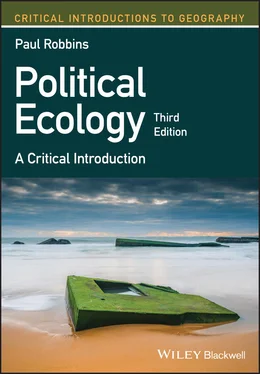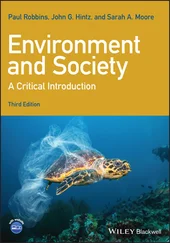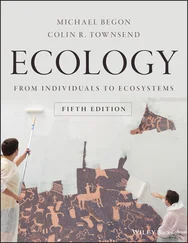A focus on production (farming, fishing, herding) as a key social‐environmental process means taking seriously the notion that “the means of production being the collective work of humanity” (Kropotkin 1990, p. 14), the business of making a living therefore provides the most direct window into the mechanisms of social and environmental interaction.
A rigorous archival and field‐based empirical approach allows detailed observations of plant and animal life as well as historical social case histories from around the world (Kropotkin 1888).
An explicit concern for marginalized and disenfranchised communities enables exploration of “institutions, habits, and customs” that, despite persistent exploitation by landlords and the state, locals prefer to maintain rather than adopt inadequate state‐sponsored solutions “offered to them under the title of science, but [that] are no science at all” (Kropotkin 1888, pp. 260–261).
A strong interest in the position and power of traditional environmental knowledge allows a pragmatic view of social and technological change. Though Kropotkin was a strong supporter of innovation, he insisted that the elements of progress could only be found in the existing resourcefulness of communities (Kropotkin 1985). The “hierarchical” forces of state and capital tend to crush “popular genius” (Kropotkin 1987).
Starting from the landscape facilitates a grounded approach to social and political analysis, especially the influence of people on environmental systems. Ever a geographer, Kropotkin was as interested in environmental change as he was in social reform (Woodcock and Avakumovic 1990).
Kropotkin's call for a critical science of environmental sustainability and equity was compelling and direct, and forecast a synthesis of social and environmental research.
The elements of Kropotkin's critical social ecology were offered at a time when geography and a nascent anthropology were anything but progressive or emancipatory tools of social and environmental changes. Even so, other contemporary researchers took critical positions against those arguments for the “natural” character of an unjust social world as well as those that ignored the human influence on the environment.
Critical approaches in early human–environment research
The late nineteenth and early twentieth centuries produced a range of critical environmental approaches, at varying scales of abstraction, which sought to describe and analyze the patterns of human interaction with the environment.
Early scientific critics: Humboldt, Reclus, Wallace, and Sommerville
Perhaps earliest in this area was Alexander von Humboldt, arguably the grandfather of modern geography, who is best known for his empirical investigations of the environment, which took him around the world during the early 1800s. Humboldt's travels brought him into contact with people making a living under a wide range of conditions and coping with varying degrees of political and economic hardship. These gave him an apparent appreciation for the political and economic context in which people make a living and cope in their daily lives.
His interaction with local producers also gave him a feeling for the unity of humanity and distaste for the racist myth of natural difference. Though his five‐volume Cosmos , which aspired to be a truly comprehensive physical guide to the universe, had only a scant few pages on humanity, and these dedicated to race, Humboldt was careful to insist that “while we maintain the unity of human species, we at the same time repel the depressing assumption of superior and inferior races of men” (Humboldt 1858, vol. 1, p. 358). Though sometimes invoking the racial language of the period and though clearly implicated in colonial‐era exploration, Humboldt was insistent that the “inequality of fortunes” between white colonials and indigenous communities could only be solved through equal access to both civil employment and fertile land (Humboldt 1811). These conclusions arose especially from Humboldt's experiences in South America, as did his sensitivity to traditional resource‐use practices and the implications of colonial economic systems for social and environmental reproduction.
In a typical example, Humboldt described at length the perilous decline of the pearl fisheries in the Cumana region of Venezuela, a unique resource whose fruits had been traded throughout the continent for generations. While allowing the possibility that tectonic forces (earthquakes and submarine currents) played some role, he was explicit that recent overfishing during the colonial period was probably to blame, since mercantile practice increasingly involved large‐scale mining of the beds, so that oyster “propagation had been impeded by the imprudent destruction of the shells by thousands.” The pearl‐bearing oyster, he added, lives only 9 or 10 years, producing pearls only after the fourth year, making the mass extraction of the oyster (a boat might collect 10,000 oysters a week) extremely destructive and only marginally profitable. He further insisted that traditional native practice, opening promising shells one by one, sustainably supported a high‐demand economy for the commodity before European contact (Humboldt 1852, pp. 191–194). Humboldt held the political history of the region to account for contemporary levels of destitution, underdevelopment, and environmental decline, rather than native practice or racial characteristics.
Like Humboldt, the French geographer Elisee Reclus was dedicated to comprehensive accounts of human and physical geography. His The Earth: A Descriptive History was only slightly less ambitious than Humboldt's Cosmos in its universal scope (Reclus 1871). The critical politics in his orientation towards human–environment questions were considerably more explicit, however. Like Kropotkin, he insisted that observation of human interaction with nature held the key to understanding society and insisted that “the sight of nature and the works of man, and practical life, these form the college in which the true education of contemporary society is obtained” (Reclus 1890, p. 10). He asserted, moreover, that eruptive political action against current systems of inequity – revolution – is part of evolutionary change in social/environmental systems. Combining an urge for justice for workers with a broader project of describing socio‐ecological change, Reclus challenged the notion that contemporary social structure and ecological practice were the inevitable products of evolutionary selection.
These kinds of challenges to social domination and imperialism can also be seen grafted into the very roots of evolutionary theory. Alfred Russel Wallace, a British geographer and naturalist, simultaneously developed the theory of natural selection while elaborating a critique of social hierarchy and land management. Wallace's travels in Amazonia and the Malay Archipelago during the mid‐1800s led him to investigate how geographic factors influenced the range of species, whether by enabling or limiting their distribution. The boundary he discovered, which passes through the South Pacific, separating the distribution of Asian animals from those of Australasia, still bears the name “Wallace’s Line” (Raby 2001). His experience also drove him to investigate how people indigenous to these regions made a living and classified the natural world. He would be remembered best, however, for his assertion that individual animals best adapted to their environments had the best chances for survival, thus influencing the emergence of differential adaptations. Several years of correspondence with Charles Darwin on the topic followed, after which Darwin's own Origin of Species (Darwin 1860) would be published. Thus Wallace became a co‐developer of the thesis of natural selection, fundamental to evolutionary theory (Gould 1996; Raby 2001).
Читать дальше












